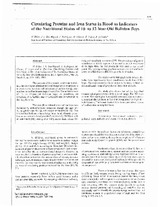Circulating proteins and iron status in blood as indicators of the mutritional status of 10- to 12-year-old Bolivian boys

View/
Date
1994Author
Téllez, W
San Miguel, JL
Rodríguez, A
Chávez, M
Lujan, C
Quintela, A
Metadata
Show full item recordAbstract
Abstract.
The purpose of the present study was to evaluate the nutritional status of children based on anthropometric measurements, biochemical indicators of protein energy malnutrition as well as hematological variables. The subjects were 93 10- to 12-year-old Bolivian boys: 12 HAHSES, 28 HALSES, 36 LALSES, and 17 LALSES (see Introduction to this Supplement). The overall nutritional status of the boys was evaluated by anthropometric indicators (weight for age [W/A], height for age [H bd, and weight for height [W/H]). The biochemical indicators included proteins total, albumin, prealbumin, orosomucoid and protein C-reactive (for MPE) as well as hematocrit (Ht), hemoglobin (Hb), serum iron, serum ferritin, and transferrin saturation (TS). The prevalence of growth retardation of LSES boys at HA as well as at LA was found to be high when the 3rd percentile was used as the cutoff point. The corresponding prealbumin levels were found to be lower in LSES than in HSES boys at both altitudes. The study shows that LSES boys at both altitudes have significantly lower prealbumin levels than HSES boys. The socioeconomic factor seems to be more critical for the nutritional status of prepubertal boys than altitude. The study also shows that all the boys had hematological parameters within normal range. The HA boys of both SES had higher hemoglobin concentration and hematocrits than the LA boys, a fact that is explained by high-altitude hypoxia. The hematological data do not provide evidence of malnutrition among the boys.
